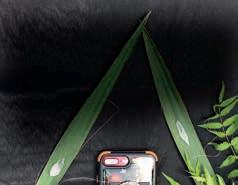
4 minute read
THE PERILS OF PLASTIC CLOTHING
EMBRACING SLOW FASHION AND SUSTAINABLE FABRICS
by Sandra Yeyati
Advertisement
Most clothes made today contain plastic. The non-biodegradable polymer is a major component of elastic waistbands and nylon sneakers. But by far, the largest fossil-fuel culprit is polyester, commonly used in shirts, pants, hoodies, dresses, jackets, underwear, socks, blankets and hats, according to Sewport, an online marketplace serving the garment industry.
In 2021, polyester comprised 54 percent of all new fabrics, according to Textile Exchange, a global nonprofit of fashion insiders promoting sustainability. Because it
Rodica/Shutterstock.com
Made from mushroom mycelium, this textile is a sustainable alternative to animal leather. is inexpensive to make, this synthetic fiber is the darling of fast fashion which entices consumers to wear cheap garments a few times, throw them away and promptly buy replacements. Every year, an estimated 92 million tons of clothing end up in landfills worldwide; and in America, 85 percent of all textiles get discarded, according to Earth.org.
Environmental Costs of Plastic Clothes
Plastic produces greenhouse gases at every stage of its long life—from extraction, refining and manufacturing to transportation and waste management. Researchers have found that washing polyester releases tiny synthetic microfibers into the water supply, harming marine life and contaminating human drinking water. It also breaks down into micro-plastics while languishing in landfills for hundreds of years.
The manufacture of polyester has social costs, too. According to Sewport, the vast majority of producers worldwide exploit uneducated people in impoverished countries, where workers are regularly exposed to highly toxic chemicals.
Recycled Plastic Textiles
Among conscientious environmentalists, there’s an aspirational trend toward textiles made of recycled plastic, such as Econyl. Patagonia promotes NetPlus material made from discarded fishing nets. Repreve transforms reclaimed water bottles into yarn that is used to make various garments. Currently, these ecofriendly textiles make up a tiny fraction of the global market; only 14 percent of all



polyester was recycled in 2020.
Textile Exchange and the United Nations Framework Convention on Climate Change’s Fashion Industry Charter for Climate Action have launched an initiative to shift the market toward recycled polyester. But even recycled plastic garments shed micro-plastics when washed. Consider using a washing bag like Guppyfriend, which keeps micro-plastics from escaping, or choose items that aren’t washed as oft en, such as sneakers.
Better Fabric Choices
“Organic and more sustainable counterparts from almost all types of natural fi bers, including cotton, linen, down and wool, are becoming available at retailers across the globe,” says La Rhea Pepper, managing director of the Textile Exchange. Here are notable fabric options that are kinder to the planet.
LYOCELL: Trademarked as Tencel, lyocell is made from sustainably sourced wood cellulose and used in denim, dress shirts and underwear. Less water and lower-impact chemicals are used in manufacturing this material. It’s biodegradable and easily recycled.
ORGANIC OR RECYCLED COTTON:
While conventional cotton is a natural fi ber harvested from plants, it consumes an inordinate amount of water and involves the use of toxic chemicals. Th e better choices are organic cotton certifi ed by the Global Organic Textiles Standards (GOTS), which requires less water and doesn’t use chemicals, or recycled cotton, which repurposes already existing fi bers.
PLANT-BASED LEATHER: Companies making these animal-free alternatives using mushrooms, pineapples, bananas, apples, cacti and other vegetables are highly innovative and represent an exciting, emerging sector.
PEACE OR AHIMSA SILK: Silk is biodegradable and requires much less water and chemicals than cotton, but it’s traditionally made by boiling or gassing silkworms. Th e crueltyfree approach behind peace or Ahimsa silk is that moths are allowed to emerge naturally before their cocoons are harvested. Look for GOTS-certifi ed silk to ensure humane manufacturing.
WOOL: Made from the fl eece of sheep and other animals, wool is naturally biodegradable, regrows continually and can be harvested without harming animals. Still, industry players have been known to abuse animals, land and workers. Certifi ers like the Responsible Wool Standard encourage better stewardship.
ORGANIC LINEN: Made from fl ax, linen requires little water, is biodegradable, moth-resistant and considered more ecofriendly than cotton.
ORGANIC HEMP: Humans have been harvesting hemp for thousands of years. It’s considered one of the most sustainable fi bers because it requires very little water and no toxic chemicals to produce.
Living with the Complexity of Environmentalism
As the annual global textile market nears $1 trillion in value, the environmental stakes are enormous, and sustainable choices aren’t always easy to make. Ultimately, it’s the new clothes we don’t buy that will help our planet the most. Vow not to purchase fast fashion. Invest in well-made, longer-lasting clothing. Mend clothes to extend their lives. Shop at secondhand stores. Wash clothing less oft en to reduce the release of micro-plastics. Choose brands committed to responsible fabrics and transparent labeling.
Sandra Yeyati, J.D., is a professional writer and editor. Reach her at SandraYeyati@ gmail.com.
PROTECT YOURSELF
FROM HARMFUL EMF!
Electromagnetic Pollution
is caused by: Cell Phones • Wi-Fi • Routers Laptop • PC • Modem Smart Meters • Water & Gas Meters Appliances: Microwave • TV • Fridge
“When I put the ¼ Cubit, 14 Gauge tensor ring on my cell phone, the tingling I was feeling in my hand immediately ceased!” ~J.D.
Neutralize EMF at its source with Marz Energy Tools and DOUBLE YOUR BENEFITS!
Our tensor rings have proven to be useful for healing and pain relief as well as EMF protection.









